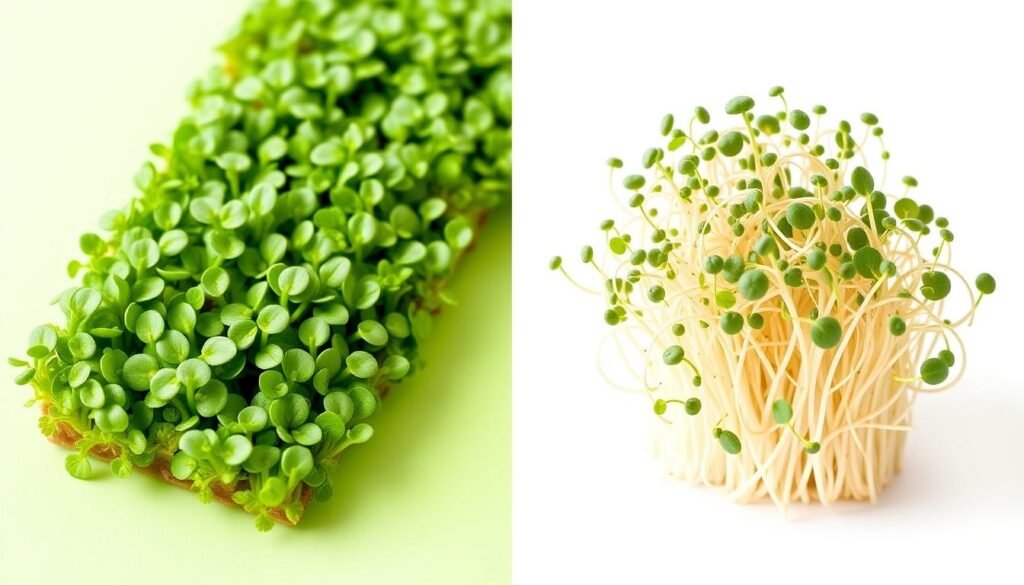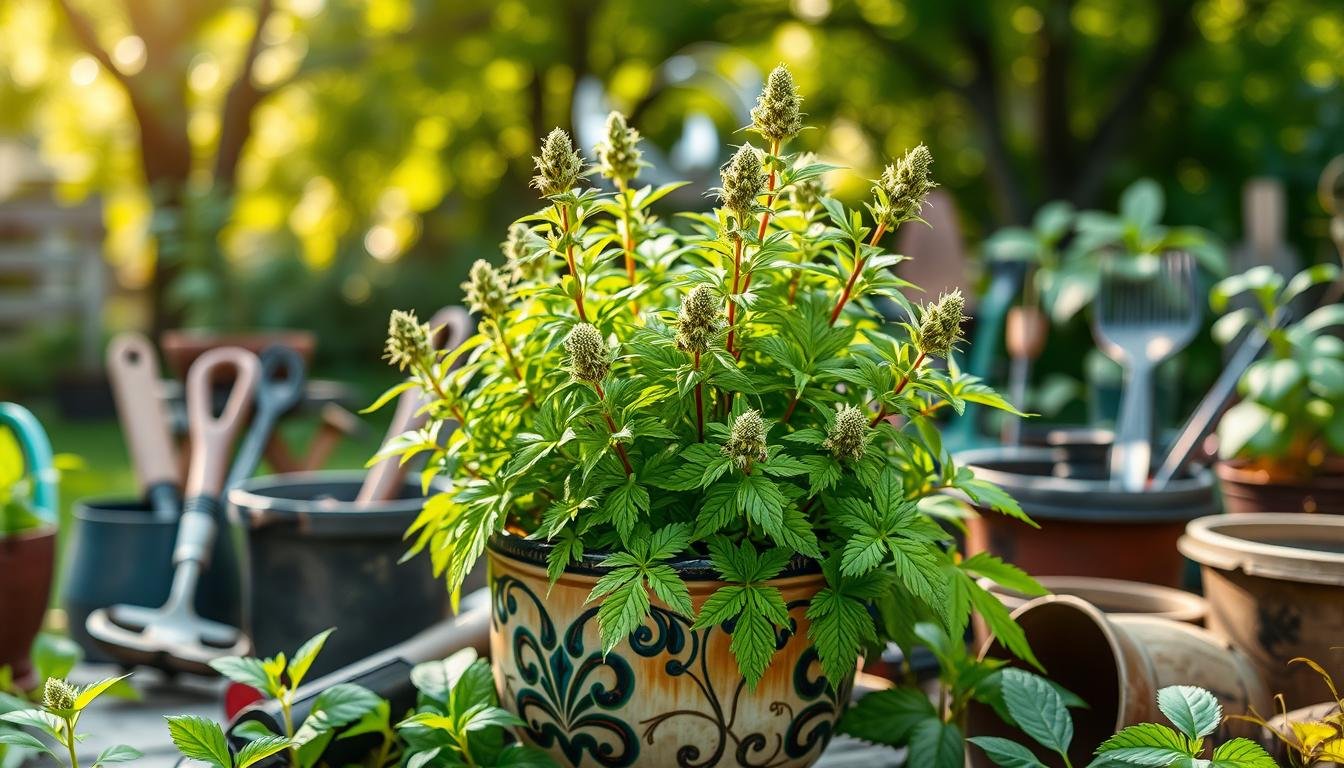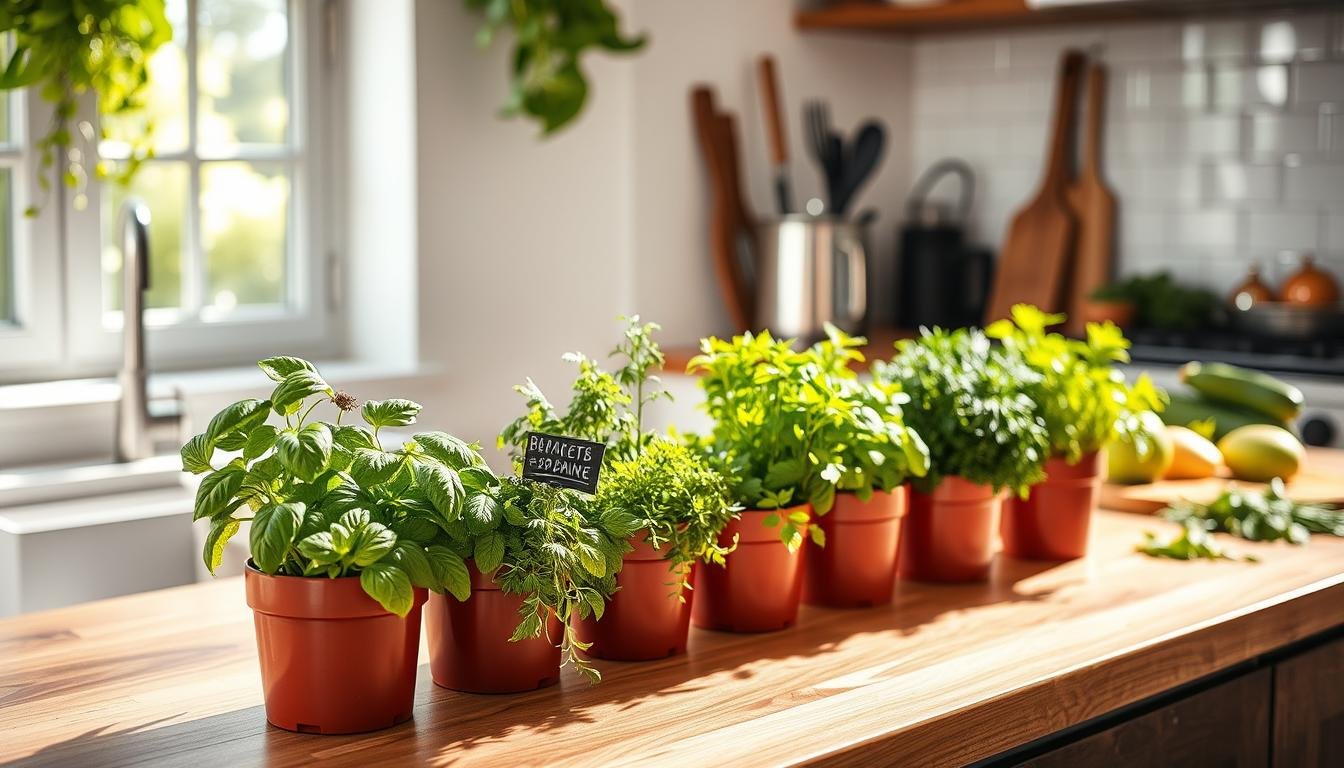Microgreens have up to 40 times more nutrients than mature veggies. This fact highlights their growing popularity in health foods. People want these nutrient-packed options more and more. This makes us look closely at microgreens versus sprouts. Knowing their differences can boost your meals and your health.
We’re going to see how microgreens and sprouts grow differently. We’ll also check out their nutrition and tastes. By the end, you’ll know exactly what makes them special. This info is great whether you love health foods or just want to try something new.
Key Takeaways
- Microgreens can provide significantly higher nutrient levels than mature vegetables.
- Understanding the differences between microgreens and sprouts is essential for healthy eating.
- The unique growing conditions impact the nutritional benefits of each.
- Flavor profiles vary dramatically between microgreens vs sprouts.
- Both options offer a variety of culinary uses.
Understanding Microgreens
Microgreens are young plants we eat at the seedling stage. They are usually ready between 7 to 21 days after starting to grow. These plants are loved for their vibrant flavors, nutritional benefits, and beauty. People enjoy adding them to salads, sandwiches, and fancy meals. Among the varieties, you’ll find arugula, radish, and basil.
The benefits of microgreens are impressive. They pack more vitamins, minerals, and antioxidants than full-grown plants. This makes them great for meeting daily nutrition needs. Many who care about health love adding microgreens to their meals.
It’s easy for anyone to grow microgreens, whether at home or for business. They don’t need much space or resources. Microgreens can live indoors or outside. Chefs and those aiming for a healthy diet find microgreens very useful.
| Type of Microgreens | Nutritional Benefits | Common Uses |
|---|---|---|
| Arugula | High in vitamins A, C, and K | Salads, sandwiches, and garnishes |
| Radish | Rich in antioxidants and vitamins | Salads, toppings for tacos, and sandwiches |
| Basil | Source of essential oils and vitamins | Pasta, pizza, and salads |
What Are Sprouts?
Sprouts are seeds that begin to grow into new plants. During the sprouting process, which lasts a few days, seeds turn into tiny seedlings. This makes them perfect for quick growing at home. They add a fresh, rich in nutrients touch to any meal.
Different types of sprouts add various tastes and textures to food. Some well-known kinds are:
- Alfalfa sprouts
- Mung bean sprouts
- Broccoli sprouts
These sprouts make food easier to digest and taste better. They’re great in salads, sandwiches, or as a topping. Due to their nutritional benefits, sprouts have gained lots of fans. The International Sprout Growers Association mentions their vital vitamins and minerals.
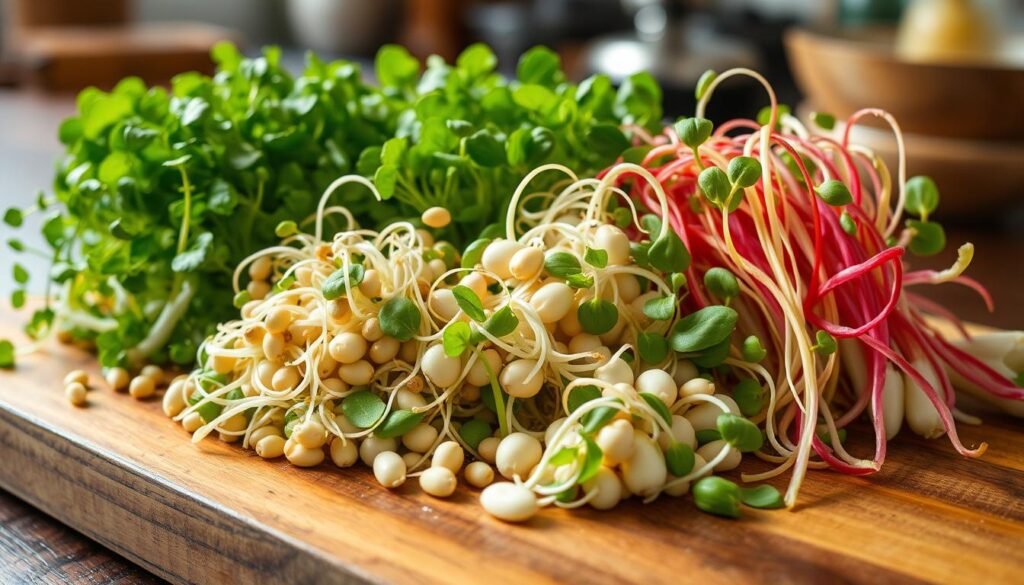
Knowing what sprouts are helps us understand their value. By including different sprouts in our meals, we improve our health. They enhance the flavor and nutritional content of our diet.
Microgreens vs Sprouts: Key Differences Revealed
Microgreens and sprouts are not the same, and they stand out in looks and taste. Microgreens grow from edible veggie and herb seeds, needing weeks to form. Meanwhile, sprouts evolve from germinated seeds in just days. They are used differently in cooking, enhancing our dishes in their unique ways.
The growth stages of these plants show more differences. To start, sprouts need a soak in water to kick off germination quickly. On the other hand, microgreens grow longer, sprouting leaves and stems before harvest. This makes them tastier and more nutritious.
On the table, sprouts and microgreens offer distinct experiences. Sprouts, crunchy and mild, work well in salads and sandwiches. Microgreens, though, boost meals with deep flavors and eye-catching looks, from fancy dinners to a simple soup topping. Both are fresh, healthy food choices.
Nutritional Value of Microgreens
Microgreens are becoming more popular because they are nutritionally valuable. They are filled with essential nutrients. They have more vitamins and minerals than many usual veggies. Studies show they are very beneficial for health.
Vitamins and Minerals Found in Microgreens
Microgreens have a lot of important vitamins and minerals. These include:
- Vitamins: A, C, E, and K
- Minerals: Calcium, magnesium, and potassium
These nutrients help with health benefits like a stronger immune system and better bone health. The USDA nutrient database says some microgreens have more of these nutrients than the same veggies grown to full size.
Comparative Analysis with Traditional Vegetables
The nutritional value of microgreens is very impressive, especially compared to traditional veggies. Research shows that generally, microgreens contain:
| Nutrient | Microgreens (per 100g) | Traditional Vegetables (per 100g) |
|---|---|---|
| Vitamin C | 150 mg | 60 mg |
| Calcium | 100 mg | 40 mg |
| Iron | 3 mg | 1 mg |
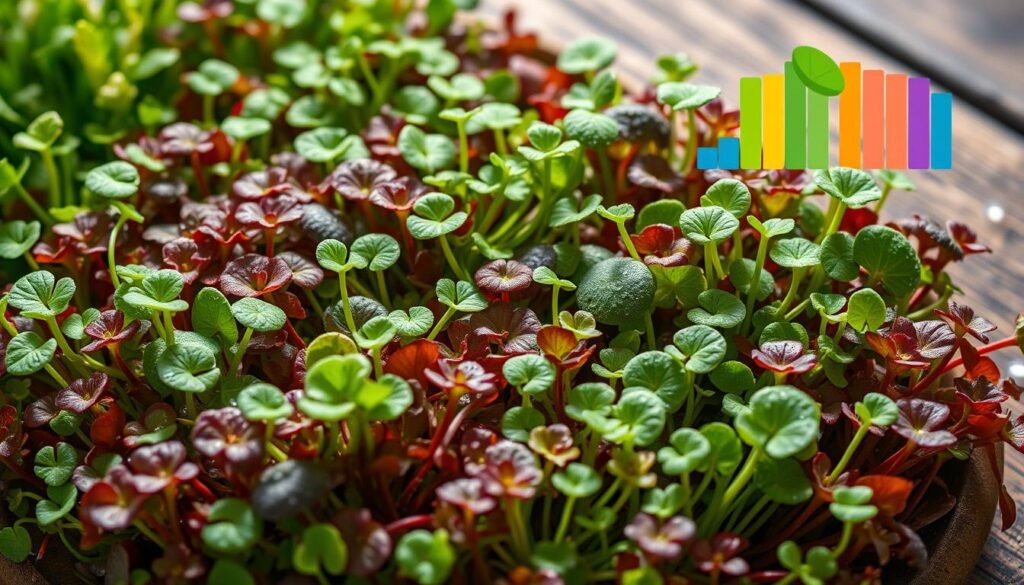
This table shows that microgreens give you more nutrients than traditional veggies. This makes them a great choice for boosting nutrition.
Nutritional Value of Sprouts
Sprouts are a powerhouse of nutrition. They offer a wide array of health benefits. Their impressive nutritional value of sprouts makes them a great addition to a healthy diet. Unlike many vegetables, sprouts are low in calories yet high in essential nutrients. This makes them a favorite among health enthusiasts.
Health Benefits of Sprouts
The health benefits of sprouts are significant. Eating sprouts regularly can improve your digestion due to their high fiber. They have important enzymes that help break down food, thus enhancing nutrient absorption. Sprouts also have high antioxidant levels, which fight oxidative stress in the body. Studies show these tiny greens help boost the immune system, promoting overall health and well-being.
Protein Content in Sprouts
Protein in sprouts is unexpectedly high. These tiny nutritional powerhouses often have more protein than traditional vegetables. This makes them a top choice for vegans and vegetarians seeking plant-based protein. Here’s a look at protein content in some common sprouts:
| Type of Sprout | Protein Content (per 100g) |
|---|---|
| Alfalfa Sprouts | 1.3g |
| Broccoli Sprouts | 2.8g |
| Mung Bean Sprouts | 3.2g |
| Radish Sprouts | 2.1g |
In conclusion, sprouts are notable for their amazing nutritional value, health benefits, and protein content. Adding a variety of sprouts to daily meals can boost health and nutrition.
Growing Conditions for Microgreens
To grow microgreens well, you need the right environment. These tiny plants do great if they get what they need. This sets you up for a big, healthy crop.
- Light: Microgreens need 12-16 hours of light each day. You can use the sun or grow lights to give them enough light.
- Temperature: They like it when it’s between 65°F to 75°F. A steady temperature helps them grow well.
- Soil: They need good soil to get nutrients. You can also use coconut coir or peat moss for better air around the roots.
- Water: Water them the right amount. The goal is moist soil but not wet.
Shallow trays and fine mist sprays are good tools for growing these plants. They make growing them easier and more successful.
If you grow them indoors, air flow is key to avoid mold. A small fan can help. Growing outside? Watch the weather since microgreens don’t like it too hot or cold.
| Growing Condition | Ideal Specification |
|---|---|
| Light | 12-16 hours per day |
| Temperature | 65°F to 75°F |
| Soil Type | Potting mix or soil-less medium |
| Watering Frequency | Moist but not soggy |
By using these tips, you can master the art of growing microgreens. Your gardening efforts will be rewarding and fun.
Growing Conditions for Sprouts
Knowing how to grow sprouts is key. There are several ways to get healthy sprouts. Each method has its own benefits and challenges. The main aim is to make conditions right for seeds to start growing.
Common Methods for Sprout Cultivation
There are several ways to grow sprouts. Let’s look at some common ones:
- Jar Method: Put seeds in a jar and soak them in water. Then, drain and rinse them a few times daily to help them sprout.
- Soil Method: Plant seeds in soil which gives them nutrients. Water regularly to keep the soil moist and help sprouts grow.
- Hydroponic Method: Here, seeds go in water with added nutrients. Keeping an eye on the water’s pH and nutrients is crucial.
Microgreens Growth Cycle
Micogreens take a bit longer to grow than sprouts. They’re usually ready to harvest in 7 to 21 days, depending on their type. Good light and steady moisture are essential. They greatly affect the sprouts’ quality and amount.
Taste Profiles: How They Differ
Microgreens and sprouts have unique taste profiles. Microgreens boast vibrant, intense flavors that can be zesty or sweet. They add a flavor burst to salads, sandwiches, and dishes.
Flavor Variations of Microgreens
Each microgreen offers a different taste. For example, cilantro microgreens have a sharp taste, while sunflower ones are nutty and creamy. They enhance both gourmet dishes and home meals.
Chefs love to experiment with their flavors. This creates complex and delicious food experiences.
Distinct Taste of Sprouts
Sprouts, though, have a milder taste. Varieties like alfalfa and mung bean are gentle and crunchy. They don’t overpower but complement dishes nicely.
People enjoy their subtle flavors in salads and wraps. Their mild taste brings balance to meals.
